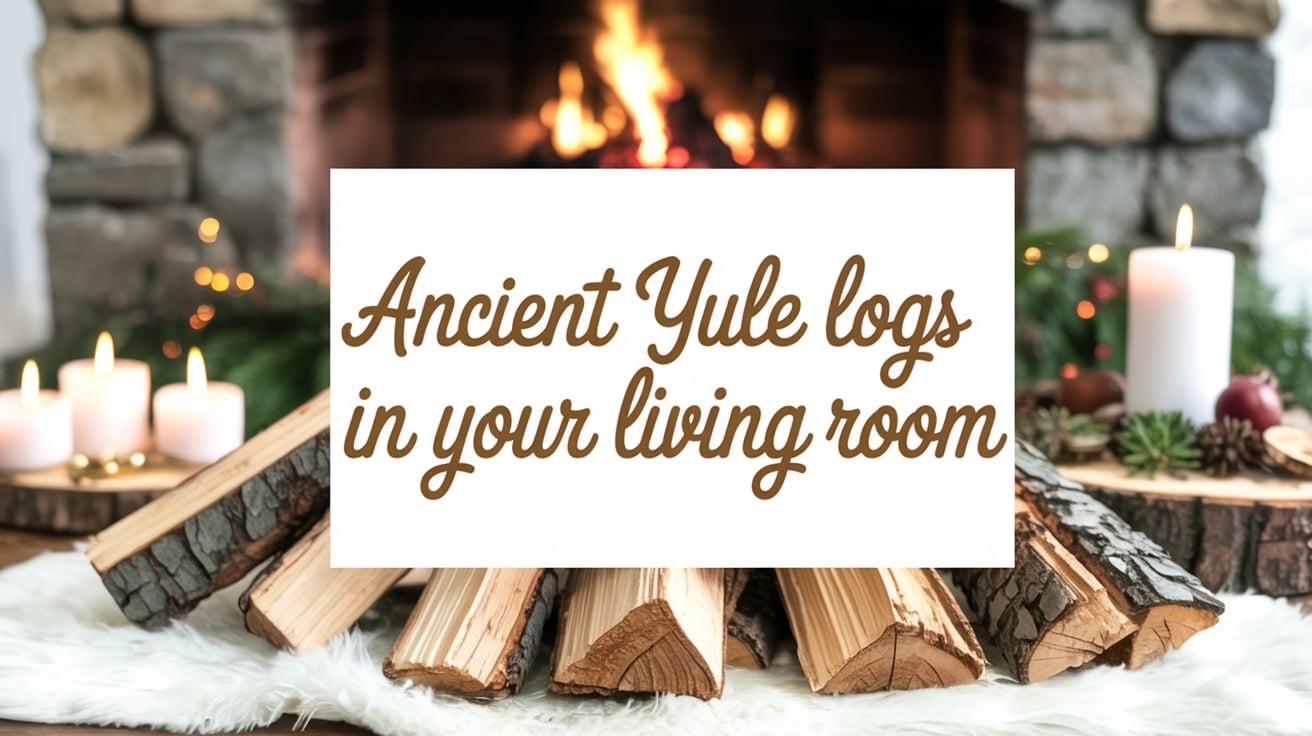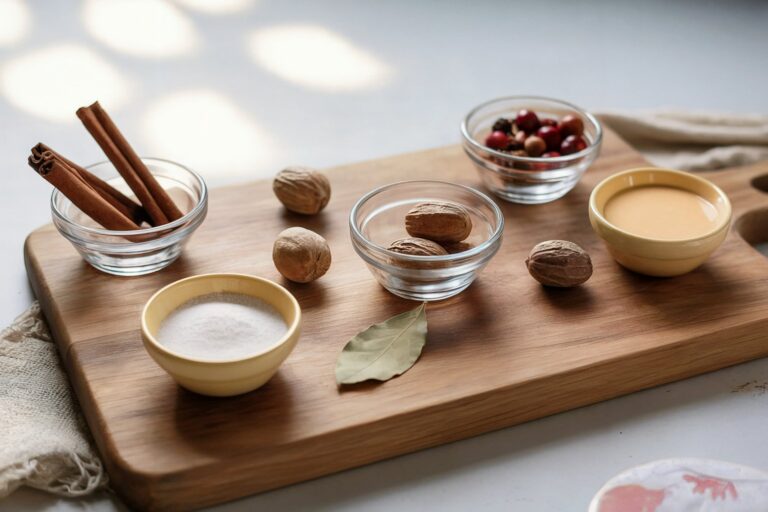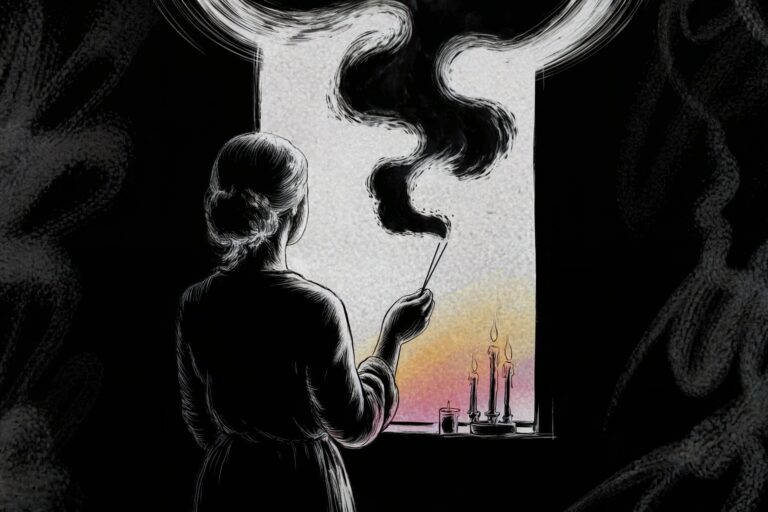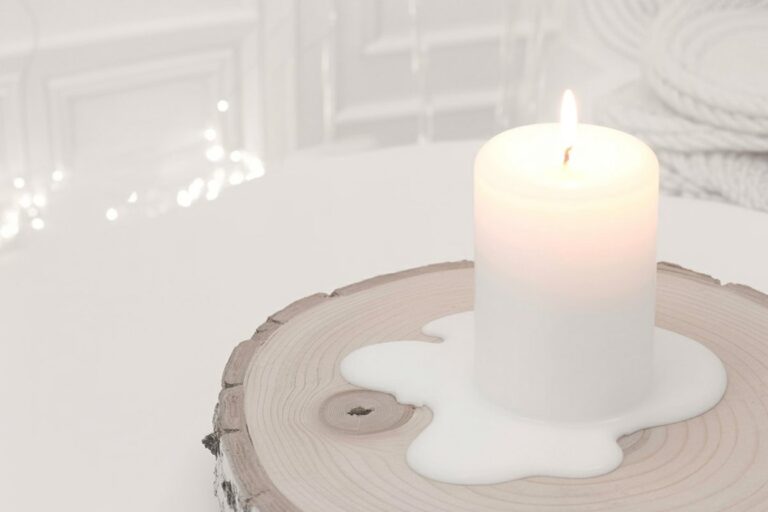Making Your Own Sacred Yule Log (Because Store-Bought Ones Are Basically Expensive Sticks)
Please note that posts on this site may contain affiliate links
Look, I’m going to be honest with you. That $60 “handcrafted artisanal Yule log” at the fancy boutique? It’s a piece of wood with some pine needles hot-glued to it by someone who’s never celebrated winter solstice in their life.
But here’s the thing about making your own Yule log. It’s not just a craft project. It’s this weird, ancient conversation you’re having with thousands of years of people who also got through winter by creating something meaningful with their hands when the world felt dark and cold.
And trust me, after years of making these things (and one spectacular Pinterest failure involving a drill, too much hot glue, and my kitchen table), I’ve learned some things.
- Why This Actually Matters
- Wood Selection (And Why It's Not That Complicated)
- Traditional Decorations That Actually Work
- The Actual Making Process (With Real Instructions)
- Setting Intentions (Without Making It Weird)
- Using Your Yule Log Throughout the Season
- When Things Don't Go According to Plan
- Budget-Friendly Alternatives
- The History You're Connecting With
- Beyond Basic: Making It More Yours
- Modern Magical Applications
- The Real Magic
- Making Peace with Imperfection
- What Happens After Winter
Why This Actually Matters
Your hands know things your brain hasn’t figured out yet. When you’re selecting wood, arranging evergreens, setting candles, you’re accessing this deep memory of seasonal survival that goes way beyond decoration.
Celtic druids burned massive oak logs during winter solstice because they understood something we’ve mostly forgotten: that creating sacred fire during the darkest time of year isn’t just symbolic. It’s practical magic for the human psyche.
The difference between buying and making your own Yule log is the difference between wearing someone else’s clothes and making something that fits your actual life. One looks fine. The other becomes part of who you are.
Real talk: I started making Yule logs because I was broke and Pinterest made it look easy. Stayed with it because there’s something about working with wood and evergreens in December that settles parts of me I didn’t know were unsettled.
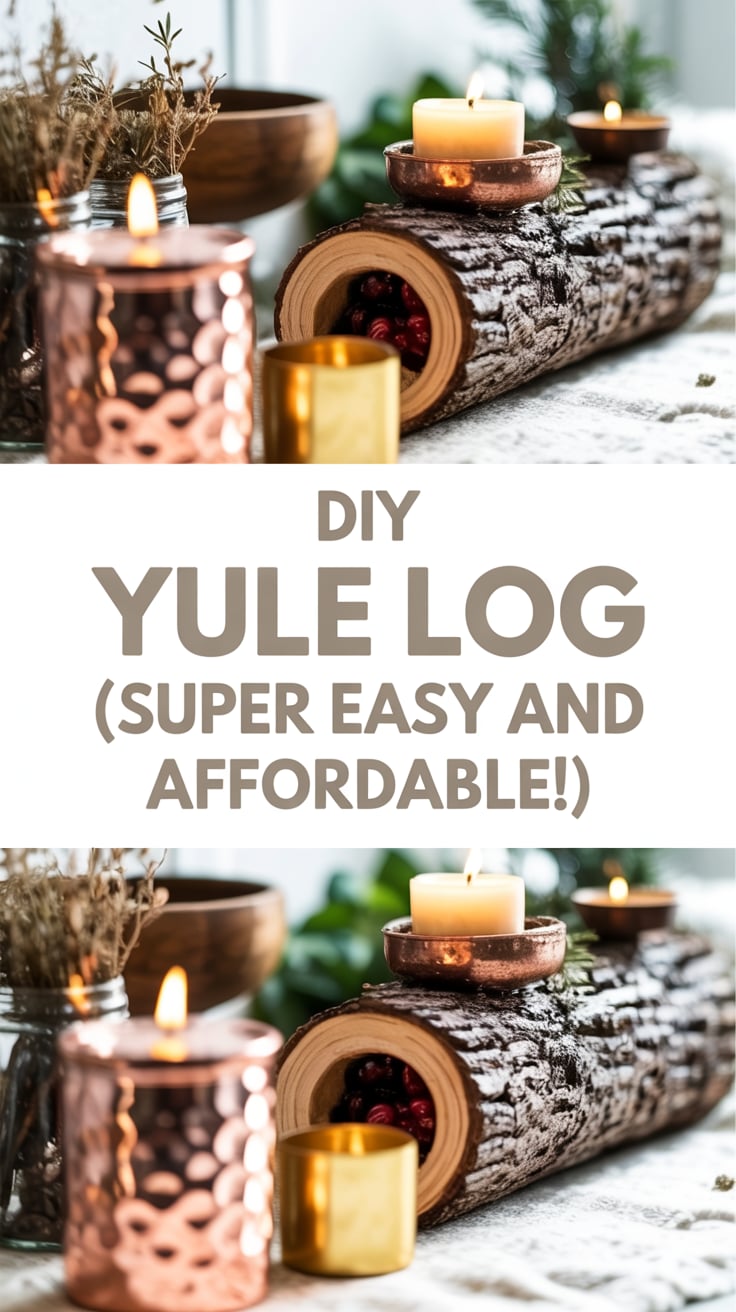
Wood Selection (And Why It’s Not That Complicated)
Everyone makes wood selection sound mystical and complicated. It’s not.
- Oak is the traditional choice because it burns forever and represents endurance. If you want your log to feel solid and permanent, choose oak. It’s what your great-grandmother would have recognized. Sacred to Celtic druids, oak logs burn slowly and steadily, representing the sun’s gradual return after solstice. Perfect for practitioners who need grounding energy during winter’s chaos.
- Birch is for new beginnings and purification. The white bark catches light in interesting ways, and there’s something clean about birch energy. Good for people starting fresh or dealing with major life changes. Choose birch if your Yule log represents releasing old patterns and welcoming fresh opportunities with the returning light.
- Pine smells like Christmas and childhood memories and forest walks. The scent actually triggers specific neurochemical responses that reduce stress. If you want your space to smell like winter magic, pine is your friend. Evergreen energy that never dies, even in winter’s depths. Pine logs fill your home with forest scent and represent eternal life force.
- Apple or Cherry (if you can find it) burns sweet and represents abundance. Fruit woods feel generous and welcoming. Apple logs burn with sweet fragrance and represent the hidden potential sleeping beneath winter’s surface, waiting to bloom again.
- Cedar is sacred purification wood used in many indigenous traditions. Cedar logs clear negative energy and create sacred space. Choose cedar if your winter practice focuses on spiritual cleansing or ancestor work.
But honestly? The best wood is whatever you can find. Fallen branches after storms. Firewood from the grocery store. That tree service truck you flagged down because you’re not too proud to ask for free wood.
The magic isn’t in the species. It’s in the choosing.
Finding Your Wood Without Looking Desperate
Storm cleanup is your best friend. After wind storms, parks departments and tree services have more wood than they know what to do with.
Hardware stores sell firewood bundles that work perfectly for smaller logs. A 12-inch piece makes a beautiful Yule log that fits on most mantels.
Apartment dwellers: Craft stores sell decorative “logs” that are basically short pieces of real wood. They’re usually birch or aspen. They work.
Facebook Marketplace and Craigslist often have people selling or giving away wood from tree removal projects. Bring cash and a pickup truck (or at least know someone with one).
Traditional Decorations That Actually Work
Evergreen Elements
The symbolism of evergreens in winter celebrations crosses multiple cultures:
- Holly is protection and masculine solar energy. Three sprigs represent the triple aspect of the season: death, dormancy, and rebirth. Look for holly with bright red berries for maximum magical potency. The holly and oak king mythology explains its winter power.
- Ivy represents feminine lunar energy that balances holly’s solar force. Ivy represents fidelity, eternity, and the persistence of life through difficult times. Fresh ivy works best, but silk alternatives maintain the symbolism.
- Mistletoe is sacred to Druids and associated with fertility, protection, and peace. Mistletoe bridges the gap between earth and sky, making it perfect for solstice magic that honors both human needs and cosmic cycles.
- Pine/Fir/Spruce – Any evergreen boughs work for representing eternal life. Fresh greenery releases aromatic oils that actually alter brain chemistry, creating the peaceful, contemplative mood perfect for winter reflection.
Traditional Seasonal Symbols
- Pinecones – Closed pinecones represent potential waiting to unfold. Open ones symbolize manifestation and abundance. The mathematics of pinecone spirals follows sacred geometry principles.
- Red Ribbons represent solar energy, life force, and the promise of returning warmth. Use natural fiber ribbons when possible – cotton, linen, or silk hold magical intention better than synthetic materials.
- Gold Elements represent the sun’s power and prosperity magic. Gold ribbon, painted pinecones, or metallic leaves all work. Even gold spray paint transforms ordinary nuts and berries into solar symbols.
- White Candles are pure light emerging from darkness. Three white candles represent past, present, and future, or the triple goddess in her winter aspect. Choose unscented candles if you want to smell the natural wood and evergreens.
The Actual Making Process (With Real Instructions)
What You Actually Need
- Wood piece (8-18 inches long, 3-6 inches wide)
- Drill with bits (or hammer and large nail if you’re improvising)
- Hot glue gun that actually works
- Evergreen pieces (real or fake, both have their place)
- White candles (3 tapers or votives)
- Ribbon (red and gold are traditional, but use what makes you happy)
- Whatever decorative stuff speaks to you
Step One: Prep Work
Sand your log if it’s rough. Don’t go crazy with this. A little texture is good. You’re making a magical object, not entering a woodworking competition.
If your wood is fresh-cut, let it dry for a few days. Wet wood and hot glue are not friends.
Safety note because someone always asks: If you’re using power tools, wear safety glasses. If you get hurt making a Yule log, the irony will be unbearable.
Step Two: Candle Holes
Measure and mark three spots along the top of your log. Space them evenly (about 2-3 inches apart works for most logs).
Drill holes slightly smaller than your candles. You want them to fit snugly but not require force. Test-fit as you go.
No drill? Use a hammer and large nail to start holes, then widen carefully with a knife. Takes longer but works fine.
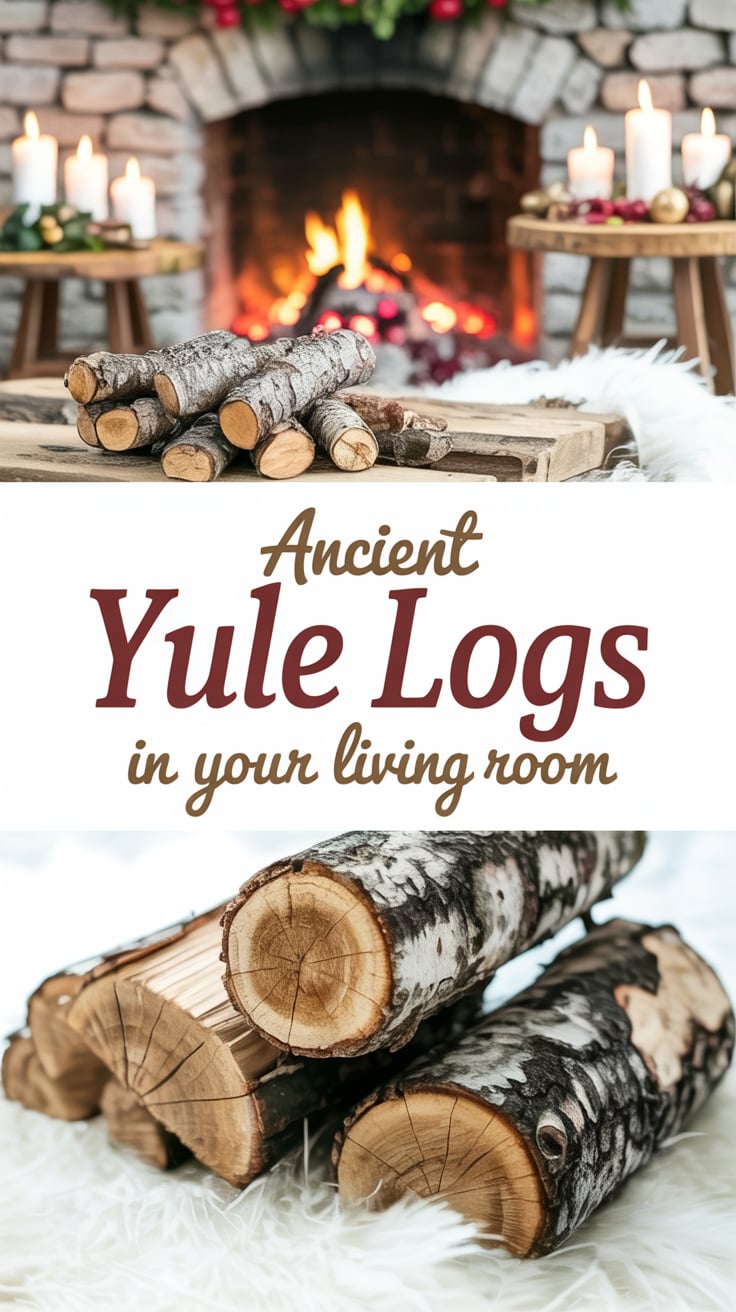
Step Three: Attach the Greenery
This is where it gets fun and messy.
Start with your larger evergreen pieces. Hot glue them along the sides and ends of your log. Work in sections, letting each area cool before moving on.
The goal is natural-looking asymmetry. Think “forest floor,” not “flower arrangement.”
Real vs. artificial debate: Real greenery smells amazing and feels more authentic. Artificial lasts all season without dropping needles everywhere. Your choice. Both work. The magic is in your intention, not the authenticity of your pine needles.
Step Four: Add Holly, Ivy, Whatever Feels Right
Holly represents masculine solar energy. Ivy is feminine lunar energy. Together they create balance.
But maybe you don’t have holly. Maybe ivy makes you think of Batman villains. Use what you can find. Rose hips, juniper berries, even interesting bare branches work.
Weave these elements through your base greenery, securing with small dabs of hot glue or thin floral wire.
Step Five: Ribbons and Final Touches
Red ribbon for life force and returning warmth. Gold for sun energy and prosperity. Traditional and effective.
But if red and gold feel wrong for your aesthetic, use what feels right. Deep forest green. Winter white. Rich purple. The colors that make you feel connected to the season matter more than following ancient color correspondences exactly.
Wind ribbon through your arrangement, creating loops and bows that look intentional but not perfect.
Step Six: Pinecones, Berries, Sparkly Things
This is where you make it yours.
Pinecones represent potential waiting to unfold. Artificial berries add color and texture. Real berries work too but might attract mice (ask me how I know).
Small crystals, metallic accents, whatever catches light and makes you smile. Hot glue them where they look natural.
Budget reality: Dollar store decorations work fine. Spray paint transforms cheap plastic into convincing metallics. The magic happens in the making, not the materials.
Setting Intentions (Without Making It Weird)
As you work, talk to your materials. Not necessarily out loud (though that’s fine too). Just internal conversation about what you want this log to represent.
Maybe it’s protection through winter. Maybe it’s hope for better times ahead. Maybe it’s just wanting your home to feel more connected to the season.
Your intentions don’t need to be profound or perfectly worded. They just need to be yours.
For deeper transformative affirmations to carry into the new year, consider what intentions you want growing as light returns.
- Protection Intention: “May this log guard our home through winter’s darkness and welcome light into every corner.”
- Abundance Intention: “As light returns, may prosperity grow in our lives like spring follows winter.”
- Healing Intention: “Through the longest night, may this sacred fire bring comfort and renewal to all who gather here.”
- Community Intention: “May this light draw loved ones near and strengthen the bonds that warm us through cold seasons.”
For the skeptics: Think of this as mindful crafting. Your words don’t need to be perfect or formal. Sincerity matters more than eloquence when creating magical objects.
Using Your Yule Log Throughout the Season
Place it somewhere you’ll see it daily. Mantel, dining table, or seasonal altar where it can anchor your winter solstice energy throughout the dark months.
Light the candles when you want to connect with winter solstice energy. During dinner. While reading. When the outside world feels too heavy.
Candle safety reminder: Never leave burning candles unattended. Trim wicks to 1/4 inch. Replace candles before they burn too low. Your beautiful Yule log shouldn’t become a fire hazard.
The candles transform your log from decoration to active magical tool. The combination of flame, evergreen scent, and seasonal symbols creates an atmosphere that actually shifts your mental state.
- Fresh Greenery Maintenance: Mist lightly every few days to keep evergreens from browning. Replace any pieces that become too dried or brittle. Your log should feel alive, not museum-perfect.
- Seasonal Storage: After Imbolc (February 1-2), you can dismantle your log and compost the natural materials. Save any reusable ribbons or decorations for next year’s creation.
Traditional Practice: Some practitioners keep their Yule log burning throughout the twelve nights of Christmas, lighting it each evening from sunset until bedtime. Others reserve it for special moments when they need winter solstice energy.
When Things Don’t Go According to Plan
- Decorations fall off: Usually means you rushed the hot glue process or your materials were damp. Reattach with fresh glue. Consider it practice in impermanence.
- Candles won’t stay lit: Check for drafts. Move your log. Switch to votive candles in small holders. Sometimes the universe is telling you to wait.
- Evergreens brown quickly: Mist lightly every few days. Keep away from heat sources. Accept that some browning is part of the natural cycle.
- Cat destroys your creation: Welcome to pet ownership. Make another one, place it higher, or accept that your cat is now part of your Yule tradition.
Perfect preservation isn’t the goal. Your log is meant to be a living part of your winter season, not a museum piece.
Budget-Friendly Alternatives
- Apartment Version: Use a smaller branch (6-8 inches) with battery-operated LED candles instead of real flames. All the magical intention remains while avoiding fire safety concerns in small spaces.
- Foraged Materials: Everything except the candles can be found free if you know where to look. Check parks after windstorms for fallen branches, and ask permission before gathering evergreens from private property.
- Minimalist Approach: A simple log with three candles and a few holly sprigs carries the same traditional power as elaborate versions. Sometimes less decoration allows the wood’s natural energy to shine through more clearly.
- Group Creation: Make Yule logs with friends or family as a seasonal gathering activity. Everyone brings materials to share, and you create individual logs while building community connections.
The History You’re Connecting With
When you make a Yule log, you’re participating in something that goes back thousands of years.
Archaeological evidence shows winter solstice celebrations dating back over 5,000 years. Celtic druids burned sacred oak logs. Norse families selected logs that could burn for twelve days, believing the fire protected their homes through the darkest season.
Early Christians adapted the practice, burning logs blessed by priests on Christmas Eve. The ashes were saved throughout the year for protection against lightning and storms. Some families kept a piece of each year’s log to light the following year’s fire, creating an unbroken chain of sacred flame.
Your smaller, safer version honors the same energy while fitting modern life.
The fascinating part: Traditional Yule logs were enormous. Entire tree trunks that required teams of people to drag home. Your tabletop version carries the same intention with significantly less back-breaking labor.
Beyond Basic: Making It More Yours
- Kitchen witch version: Add small bundles of culinary herbs. Rosemary, thyme, sage tied with string. Your log becomes both decoration and source of magical cooking ingredients. Try pairing your log with traditional Yule cookies for a complete kitchen witch celebration.
- Crystal integration: Small crystals hot-glued among your greenery. Clear quartz amplifies intention, garnet adds protection, and citrine brings abundance energy. Find the perfect stone for every intention with specific crystal guidance.
- Essential oil enhancement: Add drops of pine, cedar, or frankincense to your evergreens weekly. The scent intensifies magical properties and keeps your log smelling fresh.
- Family creation: Make individual small logs with kids or friends. Everyone brings materials to share. Creates community connection while preserving individual intention.
Modern Magical Applications
Beyond traditional decoration, your DIY Yule log becomes a focal point for winter solstice spells and rituals:
- Meditation Focus: Light the candles and gaze into the flames while setting intentions for the returning light. The combination of fire energy and evergreen scent creates ideal conditions for deep contemplation.
- Family Traditions: Use your Yule log as the centerpiece for winter solstice dinners or holiday gatherings. Its presence transforms ordinary meals into seasonal celebrations that honor both ancient wisdom and modern family bonds.
- Spell Component: Pinch small amounts of the evergreen needles or pine resin for protection spells throughout winter. Your Yule log becomes a source of magical supplies that carry your original intentions.
- Divination Tool: Ask questions while lighting the candles, then observe how they burn for insight. Fast-burning flames suggest quick manifestation, while steady burns indicate gradual, lasting change.
The key is treating your creation as a living magical tool rather than static decoration. Regular interaction maintains the energetic connection you built during its creation.
The Real Magic
Here’s what I’ve learned after years of making these: The magic isn’t in perfect technique or authentic materials or following traditional rules exactly.
The magic is in your hands working with natural materials during the darkest time of year. In creating something meaningful when everything feels temporary. In connecting with seasonal rhythms that your body remembers even when your mind has forgotten.
Your Yule log becomes a bridge between the natural world sleeping under winter snow and your warm indoor space. It reminds you daily that light returns, that dormancy prepares for growth, that your creative energy can transform ordinary materials into sacred objects.
The psychology behind it: Handmade ritual objects carry stronger emotional connections than purchased ones. Creating something with seasonal intention during winter’s darkness provides measurable psychological benefits. Seasonal Affective Disorder research shows how deeply winter affects human psychology, making these light-bringing traditions especially important.
For those drawn to working with darkness as a transformative force, winter solstice offers the perfect opportunity to embrace the longest night as sacred space rather than something to simply endure.
Making Peace with Imperfection
Your first Yule log won’t look like Pinterest. It might be lopsided. The ribbon might be crooked. Some decorations might fall off.
Good.
Perfect objects feel cold and distant. Imperfect objects feel human and alive. Your slightly wonky, beautifully imperfect Yule log will hold your energy better than any flawless store-bought version.
The Japanese concept of wabi-sabi celebrates these imperfections as beautiful. Your Yule log’s irregularities make it uniquely yours and more powerful because of it.
What Happens After Winter
After Imbolc (February 1-2), you can dismantle your log and compost the natural materials. Save ribbons and reusable decorations for next year.
Some practitioners keep their Yule log burning throughout the twelve nights of Christmas. Others save it for special moments when they need winter solstice energy.
Traditional practice: Save a piece of this year’s log to light next year’s fire, creating an unbroken chain of sacred flame. Medieval household accounts document this practice across Europe.
The wood, once your seasonal companion, returns to earth. The experience of creating and living with your Yule log becomes part of your winter solstice practice forever.
The psychology of ritual objects demonstrates that handmade items carry stronger emotional connections than purchased ones, validating what magical practitioners have always known – creation is itself transformative magic.
For more winter solstice traditions that actually work in modern life, explore 25+ magical Yule traditions or try these transformative winter affirmations to carry into the new year. And if you’re feeling the pull toward deeper seasonal practice, learn about working with darkness as transformative force during the longest night.

